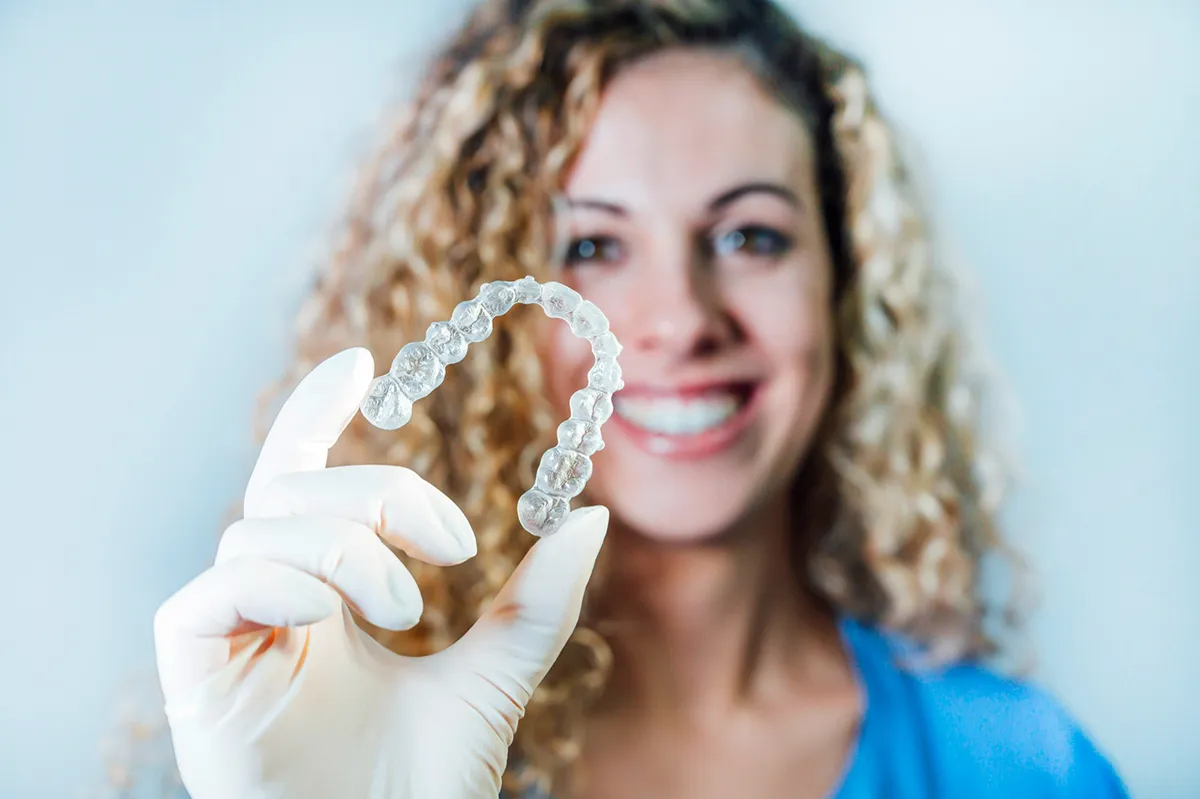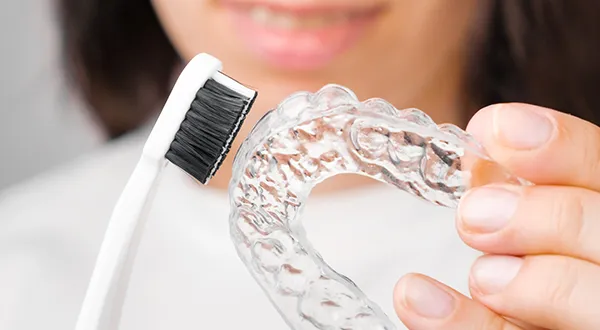

Maintaining oral hygiene with Invisalign
Maintaining oral hygiene is crucial for everyone, but it becomes even more critical for those who wear Invisalign. However, to keep your teeth and gums healthy during the treatment, you must follow some specific oral hygiene practices. This blog post will provide tips and tricks for maintaining good oral hygiene with Invisalign braces. So, whether you've just started your treatment or are a few months in, keep reading to learn how to keep your teeth sparkling clean and healthy!
Basic Oral Hygiene Practices with Invisalign
Achieving a straighter smile with Invisalign involves more than just wearing clear aligners; it requires excellent oral hygiene. Here, we'll delve into the fundamental practices that will help you keep your teeth and aligners in top-notch condition throughout your Invisalign journey.
Brushing Techniques for Invisalign Users
- Use a soft-bristle toothbrush to prevent damage to both teeth and aligners.
- Brush after every meal, as brushing prevents plaque buildup.
- Pay extra attention to brushing along the gumline and between teeth.
Flossing Tips and Considerations
- Floss daily to clean between teeth. Floss prevents gum issues.
- Consider using floss threaders or dental picks for easier access around the Invisalign aligners.
- Take your time to ensure a thorough clean without damaging the aligners.
Choosing the Right Toothpaste and Mouthwash
- Opt for a fluoride toothpaste to strengthen enamel and prevent cavities.
- Use an antimicrobial mouthwash as it can help reduce the number of bacteria present in your mouth.
- Consult your dentist about specific toothpaste and mouthwash recommendations tailored to your needs.
Cleaning Your Invisalign Aligners
Ensuring the cleanliness of your Invisalign aligners is paramount for both their longevity and your oral health. Here, we'll explore the importance of keeping your aligners clean, recommended cleaning methods, and essential dos and don'ts to maintain optimal hygiene throughout your Invisalign treatment.
Importance of Keeping Aligners Clean
- Prevents the buildup of bacteria and plaque on the aligners.
- Maintains the transparency of the aligners, ensuring discreet treatment.
- Reduces the risk of bad breath and other oral hygiene issues.
Recommended Cleaning Methods
- Rinse with Water: Gently rinse your aligners every time you remove them to remove saliva and any loose debris.
- Use Clear, Anti-Bacterial Soap: Clean your aligners with a clear, anti-bacterial soap and a soft toothbrush. Avoid colored soaps to prevent staining.
- Soak in Denture Cleaner: Soaking your aligners in a denture cleaner or Invisalign cleaning crystals helps eliminate bacteria. Follow the recommended guidelines for usage.
Dos and Don'ts for Maintaining Aligner Hygiene
- Do Brush Aligners Gently: Use a soft toothbrush to clean your aligners, but avoid abrasive materials that can scratch or damage them.

- Do Store Them Properly: When not in use, store your aligners in their case to prevent loss or damage.
- Don't Use Hot Water: Avoid using hot water to clean your aligners, as it may distort their shape.
- Don't Use Harsh Chemicals: Avoid harsh chemicals, bleach, or colored soaps, which can damage the aligners and compromise their transparency.
Managing Oral Discomfort and Sensitivity
Experiencing oral discomfort and sensitivity is not uncommon during the initial stages of Invisalign treatment. This discomfort is typically temporary and can be effectively managed.
Understanding Potential Discomfort
- Acknowledge that initial discomfort is normal as your teeth adjust to the new aligners.
- Recognize that mild soreness or pressure is often a sign that the Invisalign aligners are working to shift your teeth.
Tips for Managing Sensitivity
- Switch Aligners at Night: If you're instructed to change aligners before bedtime. This allows your teeth to adjust during sleep, minimizing daytime discomfort.
Maintaining Oral Hygiene Despite Discomfort
- Continue Regular Brushing and Flossing: Consistent oral hygiene is crucial, even if you experience discomfort. Gently brush and floss to remove plaque and food particles.
- Consider a Softer Toothbrush: If your teeth are susceptible, consider using a soft-bristle toothbrush to minimize irritation.
- Use Orthodontic Wax: Applying orthodontic wax to any rough edges of the aligners can prevent them from rubbing against sensitive areas in your mouth.
Communication with Your Dentist
- Report Persistent Discomfort: If you experience persistent or severe discomfort, communicate with your dentist. They can provide guidance and make any necessary adjustments to ensure your comfort.
Hygiene-friendly Diet and Nutrition with Invisalign
Maintaining a hygiene-friendly diet is essential during Invisalign treatment to promote overall oral health, prevent issues, and ensure the success of your orthodontic journey. Here, we'll explore dietary considerations, foods to avoid, and nutritional tips to keep your teeth and Invisalign aligners in optimal condition.
Foods to Avoid for Better Oral Hygiene
- Sticky and Sugary Foods: Minimize consuming sticky candies, caramel, and sugary snacks to prevent plaque buildup.
- Hard and Crunchy Foods: Reduce the intake of hard and crunchy foods, such as nuts and popcorn, to avoid damaging your aligners.
- Acidic Foods and Beverages: Limit acidic foods and beverages like citrus fruits and sodas, which can contribute to enamel erosion.
- Nutritional Tips for Supporting Oral Health: Include calcium-rich foods like dairy, leafy greens, and fortified options to support healthy bones and teeth. For better calcium absorption, consume foods rich in Vitamin D, like fatty fish and fortified cereals.
- Crunchy Vegetables: Opt for crunchy vegetables like carrots and celery, which can help clean teeth naturally.
- Hydration with Water: Drink plenty of water to stay hydrated and help flush away food particles, reducing the risk of plaque buildup.
Practical Eating Habits
- Remove Aligners for Meals: Take out your Invisalign aligners before eating to prevent staining and make cleaning easier.
- Brush and Rinse After Eating: If possible, brush your teeth and rinse your mouth after meals to maintain oral hygiene.
- Carry a Travel Toothbrush: Keep a travel toothbrush handy for on-the-go oral care when you can't brush immediately after eating.
- Discuss Dietary Concerns: Consult your dentist about specific dietary concerns related to your Invisalign treatment.
- Ask for Recommendations: Seek guidance on any dietary adjustments that may enhance your orthodontic experience.
Incorporating Good Habits into Your Routine
Establishing and incorporating good habits into your daily routine is crucial for a successful and comfortable Invisalign journey.
Consistent Aligner Wear
- Follow the Recommended Schedule: Wear your Invisalign aligners for the prescribed time each day. Consistency is vital for achieving the desired results.
- Transitioning to New Aligners: Adhere to the recommended schedule for transitioning to new aligners. This typically occurs every one to two weeks.
Adherence to Oral Hygiene Practices
- Regular Brushing and Flossing: Brush your teeth after meals and floss daily to prevent plaque buildup and maintain good oral hygiene.

- Clean Aligners Regularly: Clean your Invisalign aligners as recommended to ensure transparency and prevent bacterial growth.
Proper Aligner Handling
- Handle with Clean Hands: Always handle your aligners with clean hands to avoid transferring bacteria.
- Use the Case: When not in use, store your aligners in their case to avoid any damage.
Healthy Lifestyle Choices
- Dietary Considerations: Be mindful of your diet, avoiding foods that can damage aligners or compromise oral health.
- Hydration: Drink a good amount of water to stay hydrated and help maintain saliva production, aiding oral health.
Regular Dental Check-ups
- Scheduled Appointments: Attend your scheduled Invisalign check-ups and dental cleanings to monitor progress and address concerns.
- Open Communication with Dentist: Promptly share any challenges or discomfort with your dentist.
Developing a Routine
- Morning and Night Rituals: Incorporate aligner care into your morning and night routines to make it a seamless part of your day.
- Travel Preparedness: When traveling, ensure you have the tools for oral care and aligner maintenance.
Orthodontic Wax for Discomfort
- Use as Needed: Keep orthodontic wax on hand to address any discomfort caused by rough edges on the aligners.
Patience and Persistence
- Acknowledge Adjustments: Understand that your teeth may sometimes feel sore or sensitive, especially when transitioning to new aligners. This is a normal part of the adjustment process.
- Stay Committed: Remind yourself of the end goal and stay committed to the Invisalign process.
Adding these good habits into your daily routine will optimize the effectiveness of your Invisalign treatment and foster habits that contribute to a lifetime of good oral health. Consistency and diligence are critical to a successful Invisalign experience.
Contact your Lafayette dentist, Dr. Massood Darvishzadeh, DDS at Lafayette Dental Group, to learn how to maintain oral hygiene with Invisalign.
Resource:
Invisalign Express: Fast-Track Orthodontics for Minor Issues.
*This media/content or any other on this website does not prescribe, recommend, or prevent any treatment or procedure. Therefore, we highly recommend that you get the advice of a qualified dentist or other medical practitioners regarding your specific dental condition*
Services
Contact Us
3466 Mt Diablo Blvd., Suite C207
Lafayette, CA 94549
2025 © Lafayette Dental Group | All rights reserved | Powered by: Vigorant, Inc.
